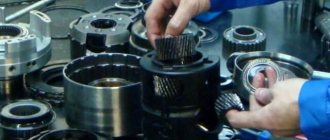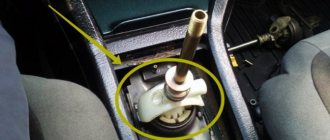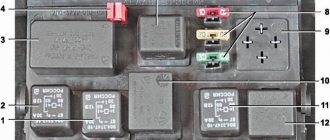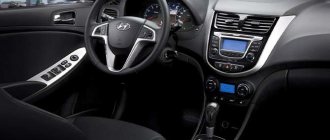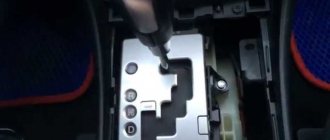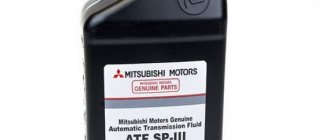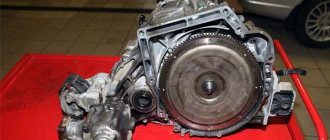Sensors in the automatic transmission
So, the main task is the smooth operation of the automatic transmission, speed of response, minimizing wear of loaded automatic transmission elements, etc.
Simply put, the electronic system must change gears at the most appropriate moment.
It is quite obvious that to implement such a task it is necessary to take into account a number of individual parameters. For this reason, the automatic transmission control unit is programmed in such a way as to dynamically select the most suitable transmission operating mode, taking into account the readings that are recorded and transmitted by the sensors.
In an automatic transmission, the main sensors are:
- speed sensor. This sensor is necessary to determine the rotation speed of the input and output shaft of the box;
- Automatic transmission oil pressure sensor, transmission fluid temperature sensor;
- automatic transmission selector position sensor, which is also called automatic transmission inhibitor or automatic transmission shift sensor;
- The automatic transmission control unit is closely connected to the ECM of the entire vehicle, which allows it to receive information from other sensors.
The automatic transmission speed sensor is one of the main elements. Often there are two such sensors, one “reads” the speed of rotation of the primary (input) shaft, while the other transmits to the ECU data on the speed of rotation of the output shaft or differential gear on automatic front-wheel drive cars.
As for the automatic transmission ECU, information from the first sensor allows the controller to determine the degree of load on the internal combustion engine and select the most suitable gear. Readings from the second sensor are needed in order to monitor the operation of the gearbox (how the ECU command is executed, whether the desired gear has been engaged, etc.)
If we talk about the speed sensor and its design, such an element is a well-known Hall sensor. Frequent problems include damage to the housing and problems with contacts. However, it will not be possible to quickly check the speed sensor with a multimeter, so during diagnostics it is recommended to install a known-good element.
Let us also add that on some cars you can also find an inductive speed sensor. The sensor works on the principle that when a gear tooth of the gearbox passes through the magnetic field of the sensor, voltage appears in the coil. This voltage forms a signal and is transmitted to the ECU.
The block takes into account the total number of gear teeth, which allows you to calculate the current speed. It is important to understand that the Hall sensor is visually similar to an inductive one, but the second option is very different in operating principle, it generates an analog signal, does not use a reference voltage, etc. By the way, the inductive sensor can be checked with a multimeter.
- The automatic transmission selector position sensor is necessary for the control unit to “switch on” the appropriate operating mode of the box. In other words, this sensor allows the unit to determine how to operate the hydraulic system, taking into account the position of the automatic transmission selector (PNRD-2-1, manual control M +/-, etc.).
Often the specified sensor is called an automatic transmission inhibitor. This sensor is usually located on the gearbox selector shaft. Also, on some automatic transmissions it can be connected to the mode selection spool valve drive in the valve body itself.
The automatic transmission selector position sensor is also responsible for turning on the reversing lights and controls the operation of the starter drive in the selector positions P and N. If we talk about the device, such sensors may differ, but they are often based on a potentiometer that changes the resistance depending on the position there is a selector.
In a nutshell, the sensor consists of resistive plates and a movable slider directly connected to the selector. Taking into account the position of the slider, the resistance of the sensor also changes, which also leads to a change in the output voltage.
As a rule, over time, this sensor may become unusable or begin to work incorrectly. In some cases, disassembling the closed case and carrying out preventive maintenance helps, but after this further malfunctions are possible. For this reason, experts recommend immediately replacing the automatic transmission selector position sensor.
- Temperature and pressure sensors record parameters directly related to ATF. An automatic transmission temperature sensor is necessary because the operation of friction clutches greatly depends on the properties of the working fluid, oil level and temperature.
In simple words, to protect the clutches and gearbox from overheating, a thermistor is installed that can change the resistance when the temperature changes. It turns out that the sensor voltage changes depending on the ATF temperature, and the corresponding signals are transmitted to the ECU.
The automatic transmission temperature sensor is installed in the gearbox housing or integrated into the wiring inside the automatic transmission housing. If, according to sensor readings, the ECU detects significant overheating, the automatic transmission usually goes into emergency mode.
As for the automatic transmission pressure sensor, indicated sensors are usually installed in the valve body channels, measure pressure readings and transmit electrical signals to the automatic transmission electronic control unit. We also recommend reading an article about how an automatic transmission works and works. From this article you will learn about the design and operating principles of a hydromechanical automatic transmission, as well as the design features of the automatic transmission.
Such sensors can be discrete and analog. The first type registers deviations from certain parameters during automatic transmission operation. Normally, the sensor contacts are closed; if the pressure drops at the location of the sensor, the contacts will be open, the ECU receives a signal and increases the pressure.
An analog sensor takes into account changes in pressure more flexibly by sending different signals. This allows the unit to more accurately make the necessary adjustments, affecting the operation of the automatic transmission.
- In the list of sensors that are used to control the automatic transmission, the electronic control unit of the automatic transmission also receives signals from other ECM sensors. For example, the unit receives signals from the brake pedal sensor to lock the selector when turning on the “parking” mode, the accelerator pedal position sensor (if the gas pedal is electronic), the TPS to determine the current load on the internal combustion engine and select the most suitable gear, etc.
Input shaft speed sensor (input speed) automatic transmission: purpose, malfunctions, repair
Among the various sensors that closely interact with the automatic transmission ECU and can cause malfunctions, we should separately highlight the automatic transmission input shaft sensor and the automatic transmission output shaft sensor.
If we are talking about the automatic transmission input speed sensor, its task is to diagnose problems, control gear shift points, adjust operating pressure, and also lock up the torque converter (GDT).
In a nutshell, the sensor transmits readings (DC or AC signals) to the control unit. The voltage signal of this sensor itself is proportional to the speed of rotation of the input shaft of the box.
Signs that the automatic transmission input speed sensor has failed or is not working correctly are a noticeable deterioration in vehicle dynamics, poor and weak acceleration, a “check” light on the instrument panel, or the automatic transmission going into emergency mode.
In such a situation, many drivers believe that the cause is low fuel quality, a malfunction of the engine power system, or contamination of the transmission oil.
It should be taken into account that instead of cleaning the injector or changing the oil in the automatic transmission, in-depth diagnostics of the automatic transmission or checking the speed sensor of the input shaft of the transmission may be necessary.
Measuring the rotation of the automatic transmission output shaft
The data obtained from determining the output shaft speed is used to adjust the operating oil pressure. Externally, the device is similar to the previous sensor.
Automatic transmission output shaft speed sensor
The main difference between input and output shaft speed meters is their number. For example, Hyundai Santa has numbers 42620 and 42621, respectively. Devices have different proportionality between speed and output signal level.
Output shaft speed meter and part number
Diagnostics should begin with checking contacts. You can check the voltage and resistance using a multimeter. A frequent breakdown is contact breakage or oxidation.
Indirect signs of failure are:
- The automatic transmission goes into emergency mode when starting to move;
- An error occurs when shifting from first to second gear.
If the motion sensor is faulty, the car continues to move. The information received by the ECU is used only when the transmission gear ratio is changed. Incorrect adjustment of oil pressure leads to shocks or failures during acceleration. The unit has low maintainability and therefore must often be replaced.
Gear shift sensor in automatic transmission: features, principles
It is a mechanism that is responsible for the peculiarities of transmitting information about the position of the lever responsible for switching speeds to the box controller. The meter is also responsible for controlling other elements.
In most cases, the gear sensor is located in the area of the selector shaft.
Causes of failure
- erasing contacts;
- if water gets inside due to a leak;
- in the absence of protection.
If the meter fails, the information does not reach the control unit.
Signs of breakdown
- if the device is broken, switching speeds up and down is not possible;
- the “HOLD” light is on;
- Restarting the engine does not solve the problem.
If the device fails, its replacement is indicated, which is best carried out by qualified services. Experienced specialists will determine the cause of the breakdown, help with repairs and efficiently replace such a meter.
Range Sensor: Features
In order to make sure that the box is working properly, you need to check the adjustment of the box range meter. This procedure is available using special diagnostic complexes and systems. The transmission range meter is used to transmit a signal about the position of the selector lever to the TCM. The position of the selector lever is assessed based on data analysis, in particular a transmission range meter.
Causes of malfunctions
The range indicator, like other elements of an automatic transmission, can break, and there may be several reasons for this.
- short circuit;
- circuit break;
- incorrect shift adjustment;
- malfunction of the start prohibition sensor;
- malfunctions in the area of the transmission range switch;
- problems in the PCM unit.
Thus, the range meter can be subject to breakdowns, and to eliminate them, qualified services for repair and replacement of individual elements are used. At the first stage, a complete diagnosis of the automatic transmission is carried out, and then the condition of the automatic transmission sensors is assessed: switching, range, lever position, turbine, speed.
Varieties
There are several varieties, mainly selectors differ in the location and shape of the handle.
- The most interesting location of the automatic transmission switch is behind the steering wheel. This arrangement is convenient for several reasons.
- The first reason is the convenience of gear shifting.
- The second convenience is that you can install a solid seat for a third passenger in the front. Thus, the automatic transmission selector was most often located on American-made cars that were produced until the early 90s.
- The second type of location of the automatic transmission gear selector is considered to be a push-button one on the dashboard. This selector was located on cars produced in the 1950s. This location is convenient for high-riding vehicles (jeeps, minivans, minibuses and others).
- Floor. This type is most often found in modern cars. Initially, the gear selector in European cars was located in the middle of the floor.
The boxes also differ in the method of protection against accidental mode switching.
When the lever is in the drive position, it is very important that the parking or reverse mode is not activated. This may lead to damage to the automatic transmission.
Some levers require either recessing or lifting to switch modes. In fact, the method works. While driving, when the lever is in the driving position, if it is accidentally touched, another mode will not turn on, and the automatic transmission will not be damaged.
In addition, if there is a sudden change in mode, the car will brake sharply, and you can get hit from behind, then repairing the car will cost even more. The unit has an additional lock button. This is not as practical as the first option, but it helps better. Here, in order to switch the mode, you will need to initially press this button. Some manufacturers make a special gear shift scheme. This is very convenient, then the driver does not need any additional presses, he just needs to move the selector along the entire route and turn on the desired mode.
There is another system of protection against accidental mode switching; this system allows you to change gear only after pressing the brake pedal.
Signs of a malfunctioning speed sensor
If problems arise with the speed sensor, the car owner can indirectly diagnose this by the following signs:
- The speedometer and odometer do not work correctly or completely. In particular, its indicators either do not correspond to reality or “float”, and chaotically. However, most often the speedometer does not work completely, that is, the needle points to the zero mark or jumps wildly or freezes. The same goes for the odometer. It incorrectly indicates the distance traveled by the car, that is, it simply does not count the distance traveled by the car.
- In cars with an automatic gearbox, the actual shifting occurs jerkily and at the wrong moment. This happens for the reason that the electronic control unit for the automatic transmission cannot correctly determine the value of the movement of the car and, in fact, random switching occurs. When driving in city mode and on the highway, this is dangerous, since the car can behave unpredictably, that is, switching between speeds can be chaotic and illogical, even very fast.
- On some vehicles, the electronic engine control unit (ECU) forcibly disables the anti-lock brake system (ABS) and/or the engine traction control system. This is done, firstly, to ensure traffic safety, and secondly, to reduce the load on engine elements in emergency mode.
- On some vehicles, the ECU forcibly limits the maximum speed and/or maximum engine speed. This is also done for traffic safety purposes, as well as to reduce the load on the engine, in particular, so that it does not operate at low loads at high speeds, which is harmful for any engine (idling).
- Activation of the Check Engine warning light on the dashboard. When scanning the memory of the electronic control unit, errors with codes p0500 or p0503 are often detected in it. The first indicates the absence of a signal from the sensor, and the second indicates that the value of the specified signal has been exceeded, that is, its value has exceeded the limits allowed by the instructions.
- Increased fuel consumption. This happens because the ECU selects a non-optimal engine operating mode, since its decision-making is based on a complex of information from several engine sensors. According to statistics, the excess consumption is about two liters of fuel per 100 kilometers (for a VAZ-2114 car). For cars with a more powerful engine, the value of the overconsumption will accordingly increase.
- The idle speed decreases or “floats”. When the car brakes sharply, the speed also drops sharply. In some cars (in particular, in some Chevrolet models), the electronic control unit forcibly turns off the engine, and accordingly, further movement becomes impossible.
- The power and dynamic characteristics of the car are reduced. In particular, the car accelerates poorly and does not pull, especially when loaded and when driving uphill. Including if it tows cargo.
- In the popular domestic car VAZ Kalina, in a situation where the speed sensor does not work or there are problems with signals from it to the ECU, the control unit forcibly turns off the electric power steering on the car.
- The cruise control system does not work on cars where it is provided. The electronic unit is turned off forcibly for traffic safety reasons on the highway.
It is worth mentioning that the listed signs of malfunction may also be symptoms of problems with other sensors or other components of the car. Accordingly, it is necessary to carry out a comprehensive diagnosis of the car using a diagnostic scanner. It is possible that other errors associated with other vehicle systems have been generated and stored in the memory of the electronic control unit.
Selector protection against accidental switching
While the vehicle is moving, it is important to prevent accidental, spontaneous shifting of the control lever into reverse or parking mode. Such a change in the position of the lever leads to breakdown of the entire automatic transmission. If you brake unexpectedly, your vehicle can also suffer serious damage from mechanical impact from another vehicle.
To eliminate or minimize the likelihood of emergency situations, manufacturers have introduced special safety protection systems into the selector design:
- using a locking selector button;
- moving the selector towards the driver before changing the next gear;
- preliminary recessing of the selector;
- previous pressing of the brake pedal.
Regardless of how the protection is designed, the automatic transmission selector needs careful, careful use. Sudden movements and impacts on the lever are not allowed.
What does automatic transmission diagnostics include?
There are two types of automatic transmission diagnostics: static and dynamic. In the instructions for the car, the manufacturer indicates mainly static testing methods, i.e. individual transmission. Check the pressure and correct closure of the clutch pack. Using a scanner, computer diagnostics are performed, identifying error codes.
Dynamic diagnostics were first proposed by Mazda in 2002. The company has developed a method for checking the timing and quality of gear shifts. The quality of switching means the simultaneous activation of one speed and the switching off of another. Delays or early switching, “running out” of the car, when there is a gap of 2 - 4 seconds between switching, is abnormal and harmful for the automatic transmission.
Checking the automatic transmission includes troubleshooting:
Initially, they inspect the car, check the level and quality of the oil, conduct a test drive to collect symptoms of problems: extraneous sounds, delays when switching, jolts, jerks, increased engine speed, etc. After collecting symptoms, electrical circuits are rung and error codes are cleared.
At the next stage, change the transmission fluid, remove the pan, and check the condition of the filter. In difficult cases, the automatic transmission is completely disassembled and individual components are tested.
Restoring the operation of the automatic transmission selector
Like any unit of complex design, the gear shift lever in an automatic transmission can also break or fail. A large number of options for insurance systems does not exclude possible breakdowns of the automatic transmission selector. Timely diagnostics, high-quality repairs and replacement of individual selector elements are a guarantee of safety on the road.
Important: Experienced car enthusiasts claim that the main difficulty in repairing an automatic transmission selector is disassembling this device. If the owner of the car does not know how the automatic transmission selector works and does not have technical skills, you should not disassemble the automatic transmission components yourself, including the gear shift lever.
Depending on the car model, the elements of the automatic transmission control system have unique specifics. If the selector is out of order and does not respond to influences, it is recommended to seek help from specialized service companies. Here, computer diagnostics of the device will be performed. Without eliminating the causes of problems in the automatic transmission selector, center workers are in no hurry to delete error codes.
Design and functions of the selector lever position sensor
Based on the name of the sensor, it is easy to guess what it is responsible for. If the on-board electronics are working properly and the ECU can continuously read the signal from the device, then the entire system works as follows:
- The driver selects the position of the selector lever;
- The slide takes the appropriate position and the sensor fixes it, and then transmits a signal to the automatic transmission control unit;
- The ECU starts the most suitable program;
- Depending on the received signal, the hydraulic system begins to operate in the appropriate mode - the necessary valves open, the friction discs are clamped and the corresponding gear is engaged.
Despite the fact that the sensor determines the position of the selector and works in tandem with the on-board electronics, it must perform several side tasks and be responsible for the normal operation of other components. In particular, he is responsible for:
- Turning on the reversing lamps;
- Monitoring the operation of the starter in selector positions “P” and “N”.
At its core, the selector position sensor is a potentiometer. We remind you that a resistor having a movable tap contact is usually called a potentiometer. Its resistance depends on the position of the slider. Unlike a rheostat, a potentiometer regulates voltage. Depending on the value of the electrical resistance, the output voltage changes in it, which is recorded by the electronic unit. Usually the sensor is fixed with Torx T 27 and is easy to dismantle, but the housing is not always dismountable, which can become a problem when trying to repair rather than completely replace the device. In this case, it may be necessary to drill out the rivets.
Automatic transmission selector replacement
Replacing the automatic transmission selector of a car is carried out for various reasons. For example, such a procedure may be necessary if an element breaks down. The mechanism is not designed for heavy physical exertion. Switching modes (if work occurs within the framework of normal operation) is carried out with light movements. If you have to make physical efforts, there is a malfunction. Also, at fairly high mileage, wear and tear of the finish occurs. Of course, this does not affect the operation of the selector in any way, but from an aesthetic point of view, it rather spoils the interior. You can often find a car owner wanting to install a different selector. For example, from a sports modification of the same model. This process can be classified as interior tuning.
Gearbox control
Unlike a manual transmission, where gear selection and engagement are done manually, an automatic transmission relieves the driver of such work. Firstly, in the configuration of such a machine there is no clutch pedal, so it will not be possible to independently open the connection between the power plant and the transmission. Here this task is entrusted to the shoulders of the torque converter, which transmits energy due to the pressure of the working fluid. The process is completely controlled by a computer, which analyzes information collected from numerous sensors.
In this case, the driver can only select the required operating mode of the unit. That is, if you need to move forward, you should move the lever to the Drive position, if back - Reverse. There is also a transmission lock mode - Parking, which is set to stop the car from moving. There is a Neutral mode, which is most often used to move the car during service - it provides the opportunity to roll freely. There are also additional functions, for example, a sports mode, which changes the configuration of the ECU. Speed shifts occur later, allowing you to achieve high engine speeds at each stage.
Performing operations
Replacing an automatic transmission selector requires the purchase of an element. Note that it is possible to purchase both new and used parts (the price in the second case, naturally, will be significantly lower). That is, you can order an element both in an auto parts store and at a thematic analysis. The choice usually depends, first of all, on the budget of the event.
Let's consider the main stages:
- Dismantling the central tunnel lining
- Disabling the selector
- Removing an element
- Installing a new part
- Assembly
Be careful when dismantling elements. Many of them have rather fragile fasteners that can be easily damaged by careless actions.
Features of working with the selector on various cars
In Toyota Crown jzs171, the selector is located under the bottom near the right wheel. You can find it by the cable coming from the lever. The unit has low mechanical strength, so it may fall apart when disassembled. Before you disassemble the contact group, you need to find the pinout of the contacts for your car, since the Toyota Crown has several connector options.
When performing work on the Land Rover selector, it is advisable to have an assistant. Checking the gearbox's response to lever positions is only possible from inside the car. When disassembling the unit, it is necessary to check the functionality of the backlight bulbs, as they often fail.
Honda CR V has very flimsy contacts of the selected automatic transmission mode sensor. The lubricant used in the contact group has a short lifespan, so it is recommended to replace it every time the unit is disassembled. Otherwise, abrasion of the contact lamellas will occur at an accelerated rate.
Citroen C5 has contacts that are poorly resistant to corrosion, so most unit malfunctions are associated with oxidation deposits. It is recommended to clean contacts using acetone. When choosing a lubricant, you should check for the presence of corrosion inhibitors and high dielectric properties.
If a selector malfunction is detected, further operation of the car can lead to serious problems with the automatic transmission. Irregularities in the operation of the automatic transmission jeopardize the safety of driving a car. Also, breakdowns of the unit are accompanied by a loss of comfort from driving a car, since you have to switch the lever several times to operate.
Temperature sensor
Transmission temperature measurement is not used on all vehicles. The main functions that the sensor provides:
The main symptoms of incorrect temperature measurement are:
For accurate diagnosis, reading the error with a special scanner is required. If the equipment is missing, you can check the sensor by replacing it with a known good one. You should also visually inspect the contacts and housing for mechanical damage.
It is prohibited to use a vehicle with faulty automatic transmission sensors. In addition to the loss of comfort from driving a car, as a result of the ECU receiving unreliable information, the car's power plant can suffer serious damage. The safety of the car is also reduced, since slipping and jerking while changing gear ratios can cause the driver to skid and lose control.
Source
Let's sum it up
Thus, all automatic transmission sensors - range, shift, turbine (power train) - must be replaced. To ensure a long service life, it is recommended to contact specialized service stations. There are other sensors, for example, a turbine input shaft rotation meter, which is inextricably linked with the quality functioning of the entire system.
Sources
- https://KrutiMotor.ru/datchiki-akpp/
- https://KrutiMotor.ru/datchik-chastoty-vrashheniya-vhodnogo-vala-akpp/
- https://akppoff.ru/remont-akpp/datchik-chastoty-vrashheniya-vhodnogo-vala-akpp
- https://akpphelp.ru/datchik_vkhodnoj_skorosti_akpp.html
- https://SwapMotor.ru/korobka-peredach/datchiki-akpp.html
- https://automend.ru/articles/datchiki-akpp-zachem-nuzhny-i-kak-rabotayut/
- https://portalmashin.ru/service/transmission/datchik-diapazonov-akpp.html
- https://portalmashin.ru/service/transmission/selektor-korobki-avtomat-akpp.html
- https://motoran.ru/interesnoe/selektor-akpp
- https://SwapMotor.ru/tehnicheskoe-obsluzhivanie/selektor-akpp.html
- https://www.qmotors.ru/service/transmission/akpp/zamena-selektora-akpp/
[collapse]
